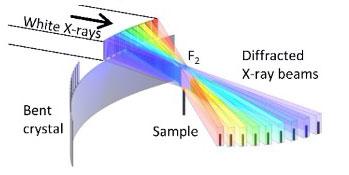Unlocking the gate to the millisecond CT

How the bent crystal changes the direction of the X-rays. Credit: Tohoku University
Now a research team – led by Tohoku University Professor, Wataru Yashiro – has developed a new method using intense synchrotron radiation that produces higher quality images within milliseconds.
High-speed, high-resolution X-ray CT is currently possible using intense synchrotron radiation. However, this requires samples to be rotated at high speed to obtain images from many directions. This would make CT scans more akin to a rollercoaster ride!
Extreme rotation also makes controlling the temperature or atmosphere of the sample impossible.
Nevertheless, the research team solved this conundrum by creating an optical system that splits single synchrotron X-ray beams into many. These beams then shine onto the sample from different directions at the same time; thus, negating the need to rotate the sample.
This “multi-beam” method is no easy task since the direction of X-rays cannot be easily changed. Unlike visible light, X-rays interact with matters weakly, making it difficult to utilize mirrors and prisms to change the path of the beams.
To overcome this, the research team used micro-fabrication techniques to create uniquely shaped crystals. These crystals were then bent in the shape of a hyperbola. By combining three rows of crystals, the multi-beam optics were able to cover an angle of ±70°.
Carrying out their experiments at the SPring-8 synchrotron radiation facility, the research team took advantage of a cutting-edge compressed-sensing algorithm that needs only a few dozen projection images for image reconstruction.
“The invention makes 3-D observations of living beings and liquid samples within milliseconds possible” exclaimed Professor Yashiro. “Its possible application is wide-spread, from fundamental material science to life sciences to industry,” added Yashiro.
Media Contact
All latest news from the category: Physics and Astronomy
This area deals with the fundamental laws and building blocks of nature and how they interact, the properties and the behavior of matter, and research into space and time and their structures.
innovations-report provides in-depth reports and articles on subjects such as astrophysics, laser technologies, nuclear, quantum, particle and solid-state physics, nanotechnologies, planetary research and findings (Mars, Venus) and developments related to the Hubble Telescope.
Newest articles

Webb captures top of iconic horsehead nebula in unprecedented detail
NASA’s James Webb Space Telescope has captured the sharpest infrared images to date of a zoomed-in portion of one of the most distinctive objects in our skies, the Horsehead Nebula….

Cost-effective, high-capacity, and cyclable lithium-ion battery cathodes
Charge-recharge cycling of lithium-superrich iron oxide, a cost-effective and high-capacity cathode for new-generation lithium-ion batteries, can be greatly improved by doping with readily available mineral elements. The energy capacity and…

Novel genetic plant regeneration approach
…without the application of phytohormones. Researchers develop a novel plant regeneration approach by modulating the expression of genes that control plant cell differentiation. For ages now, plants have been the…





















